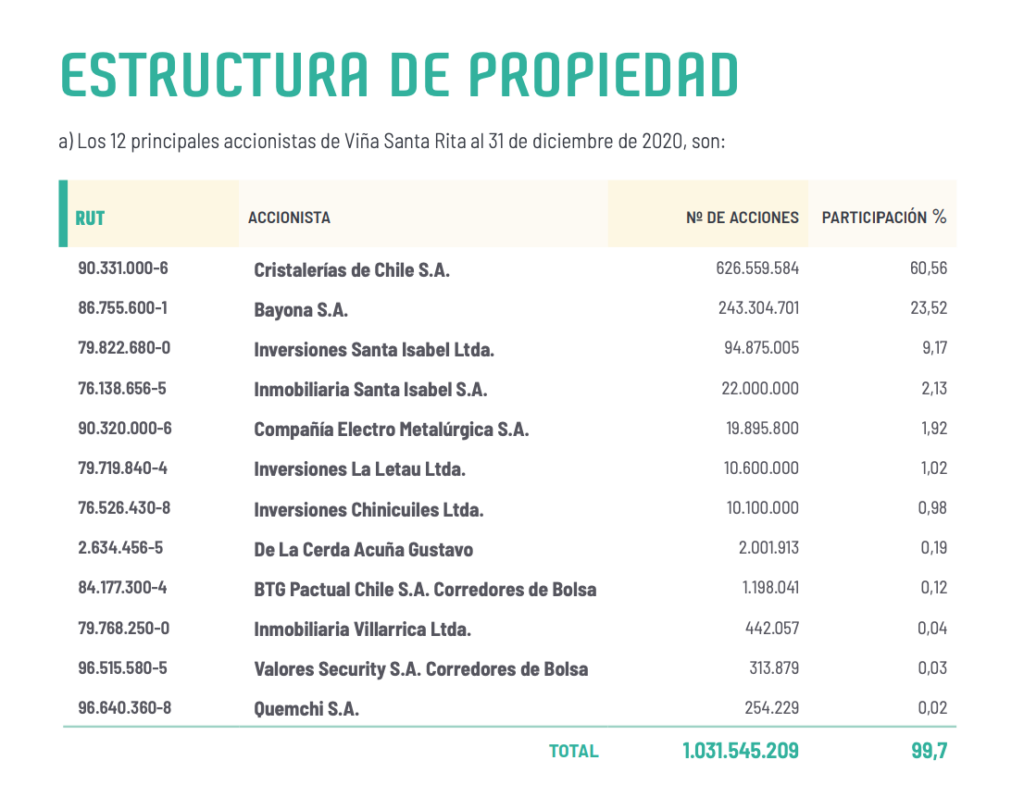Common Stock: Vina Santa Rita
Current Market Price: $144 CLP
Market Capitalization: $149 Billion CLP ($189.3 Million USD)
*All values in this article are expressed in Chilean Pesos (CLP) unless otherwise noted.
**The bulk of this analysis is based on the company’s most recent audited financial report, which can be found by following this link.
Vina Santa Rita Stock – Summary of the Company
Vina Santa Rita is a Chilean wine company. They have 3,980 hectares planted in Chile and Argentina and export their wine to over 70 countries. In addition to their core wine business they also have tourism businesses attached to their wine assets, such as hotels, restaurants, tours, and weddings.
The company is growing its online presence, realizing 56,000 sales online in 2020.
Santa Rita was founded in 1880 and is headquartered in Santiago, Chile
Revenue and Cost Analysis
Santa Rita had total revenue of $168.6 billion ($216.8 million USD) in 2020, an increase from $161 billion in 2019. Their COGS was $102.2 billion in 2020, representing a gross margin of 39%, equal to their gross margin in 2019.
The company was profitable in each of the last two years. In 2020 Santa Rita had net income of $7.5 billion, representing a profit margin of 4%, equal to their profit margin in 2019.
In 2020 Santa Rita exported 3,262,000 cases of wine at an average price per case (12 bottles of 750ml) of $27.70 USD.
Balance Sheet Analysis
Santa Rita has a strong balance sheet. They have a solid base of long term assets, a strong near term liquidity position, and are not leveraged, with reasonable liability levels.
Vina Santa Rita Stock – Share Dynamics and Capital Structure
As of year-end 2020 the company has 1.03 billion common shares outstanding.
The company’s shares are very tightly held, with the 12 largest shareholders owning 99.7% of the company. Obviously this implies that daily trading volumes are very low, if the stock trades at all.

Dividends
Based on 2020’s results, the company paid a dividend of $2.18 in April 2021. At the current market price this implies a dividend yield of 1.5%.
Vina Santa Rita Stock – 3 Metrics to Consider
Debt to Equity Ratio
Total Liabilities/Total Share Holder Equity
$133.4 billion / $178.5 billion = .75
A debt to equity ratio of .75 indicates that Santa Rita uses a mix of debt and equity in its capital structure, but is not leveraged, and relies more heavily on equity financing for funding.
Working Capital Ratio
Current Assets/Current Liabilities
$140.9 billion / $52.1 billion = 2.7
A working capital ratio of 2.7 indicates a strong liquidity position. Santa Rita should not have problems meeting its near term obligations.
Price to Book Ratio
Current Share Price/Book Value per Share.
$144 / $168 = .86
Santa Rita has a book value per share of $168. At the current market price this implies a price to book ratio of .86, meaning the company’s stock currently trades at a discount to the book value of the company.
Vina Santa Rita Stock – Summary and Conclusions
Santa Rita is an impressive company. They have been operating since 1880 and export their products around the world to over 70 countries. The company has diversified farming operations in Chile and Argentina and in addition to their wine business they also have tourism businesses that fit perfectly with their core assets.
The company is very healthy financially, with a strong liquidity position, profits, and a decent dividend. Santa Rita is the kind of business I love, a long history of operation in a slow and steady industry where gains can compound long term. Clearly I am not the only investors who loves the business, since only 0.3% of the company’s shares float.
I will add Santa Rita to my watch list, and look at a few other public wine companies in Chile before making my final decision.
Investors can also consider Chilean fish company BluMar.
Disclaimer
This is not investment advice. Nothing in this analysis should be construed as a recommendation to buy, sell, or otherwise take action related to the security discussed. If I own a position in the security discussed, I will clearly state it.
This is not intended to be a comprehensive analysis and you should not make an investment decision based solely on the information in this analysis. I hope this serves as a useful starting point for a more comprehensive analysis, and hopefully draws attention to aspects of the company that were overlooked or merit further investigation. This is by no means intended to be a complete analysis. Again, this is not investment advice, do your own research.